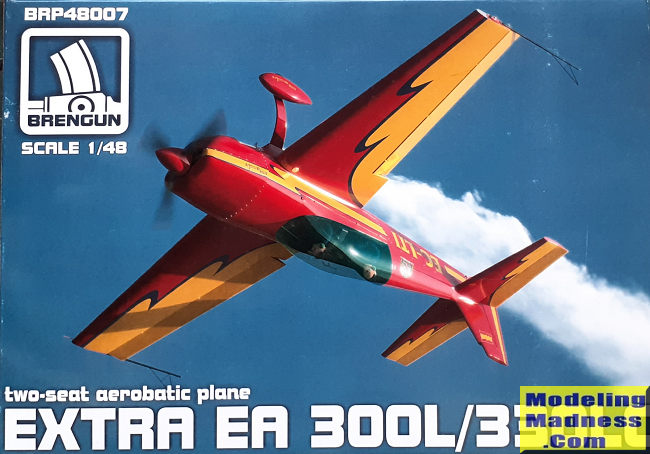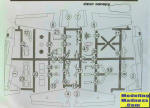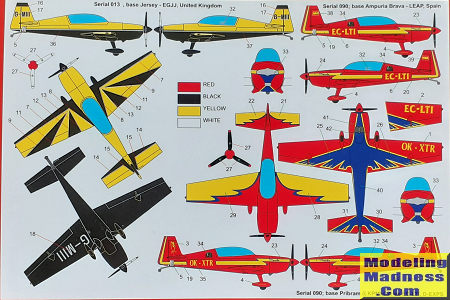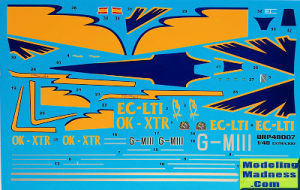
Brengun 1/48 Extra EA300L
| KIT #: | 48007 |
| PRICE: | $52.00 |
| DECALS: | Two options |
| REVIEWER: | John Summerford |
| NOTES: | Photo-etch is a separate purchase for $22.00 |

| HISTORY |
The Extra Flugzeugbau EA-300 is a two-seat aerobatic monoplane capable of Unlimited category competition. It was designed in 1987 by Walter Extra, an award-winning German aerobatic pilot and built by Extra Flugzeugbau. Design of the Extra EA-300 was based on the Extra EA-230, an early 1980's monoplane having a wing made of wood. The Extra EA-300 has a welded steel tube fuselage covered in aluminum and fabric. The mid-set wing has a carbon fiber composite spar and carbon composite skins. A symmetrical airfoil, mounted with a zero angle of incidence, provides equal performance in both upright and inverted flight. The landing gear is fixed taildragger style with composite main legs and fiberglass wheel pants. The powerplant is a fuel-injected Lycoming AEIO-540 which produces 300 hp (224 kW).
The first two-seat Extra EA-300 made its maiden flight on 6 May 1988, with German type certification following on 16 May 1990. The single seat Extra EA-300S flew on 4 March 1992.
The Extra EA-300 is stressed for ±10“g” with one person on board and ±8Ig with two. Some Extra EA-300's are certificated in the Experimental Category in the U.S., while others are certificated in the Aerobatic category.
Extra EA-300L is also a two-seat version with low mounted wing and shorter fuselage. More Extra EA-300L aircraft have been produced than any other model. Its wing is mounted at the bottom of the fuselage, with its span reduced from 26 ft 3 in (8.00 m) to 24 ft 3 in (7.39 m). Improved ailerons boost the EA-300L's roll rate to 400 degrees per second. All EA-300L's are fully certified under FAA and European Joint Aviation Authorities regulations.
| THE KIT |
 Unlike
most of Brengun’s products, this is an injection molded kit. It comes in an
end-opening box and consists of two sprues of blueish-gray crisply molded
sprues that look similar to Airfix’s offerings. The backside of the box has
color information. Sidewall detail is molded into the fuselage halves.
Overall detail might be a bit overstated, but with a flashy paint scheme,
that may not be an issue. A four bladed prop is included, but not for use
with this airframe.
Unlike
most of Brengun’s products, this is an injection molded kit. It comes in an
end-opening box and consists of two sprues of blueish-gray crisply molded
sprues that look similar to Airfix’s offerings. The backside of the box has
color information. Sidewall detail is molded into the fuselage halves.
Overall detail might be a bit overstated, but with a flashy paint scheme,
that may not be an issue. A four bladed prop is included, but not for use
with this airframe.
The instructions are on a bi-fold sheet and includes a parts map. The only text is generic color call-outs in Czech and English. Assembly starts with subassemblies for the cockpit, prop, and wheels. The cockpit gets trapped in the fuselage halves, followed by attaching the wings and stabs. Underside details come next and the canopy is added last.
 To model an
acrobatic aircraft, one can either scratch build the reference rods for the wing
tips, (clearly in view in the cover photo) or buy the photo-etch fret. The fret
also includes an instrument panel with acetate dials, seat belts, and a few
other details.
To model an
acrobatic aircraft, one can either scratch build the reference rods for the wing
tips, (clearly in view in the cover photo) or buy the photo-etch fret. The fret
also includes an instrument panel with acetate dials, seat belts, and a few
other details.
 Decals are
provided for two aircraft. Trim lines and ID lettering are provided for an
English plane painted black and yellow that the modeler will have to reproduce.
The aircraft seen on the cover is a red Spanish plane with yellow and blue
markings and is the second option. Those markings are provided as decals.
Decals are
provided for two aircraft. Trim lines and ID lettering are provided for an
English plane painted black and yellow that the modeler will have to reproduce.
The aircraft seen on the cover is a red Spanish plane with yellow and blue
markings and is the second option. Those markings are provided as decals.
| CONCLUSIONS |
 It’s
annoying that the photo etch comes separately at additional cost (including
another shipping fee) but it’s a “must-have” to build an accurate model. The low
parts count and conventional assembly sequence should make for a relatively
quick build even if it is a short-run kit. Of course, the use of the photo-etch
pieces will add to the time.
It’s
annoying that the photo etch comes separately at additional cost (including
another shipping fee) but it’s a “must-have” to build an accurate model. The low
parts count and conventional assembly sequence should make for a relatively
quick build even if it is a short-run kit. Of course, the use of the photo-etch
pieces will add to the time.
If one chooses to model the Spanish aircraft, perhaps the best way to finish the model is to paint it entire entirely red to avoid masking and don’t worry if the yellow decals are not opaque, at least they will be consistent.
April 2022
Back to the Previews Index Page
Back to the Previews Index Page